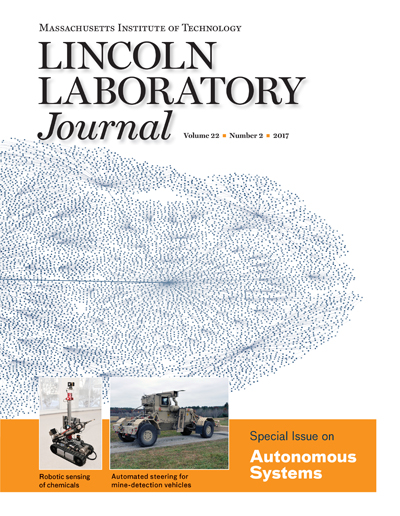Lincoln Laboratory Journal - Volume 22, Number 2

Volume 22, Number 2 - 2017
Special Issue on Autonomous Systems
Letter from the Director
Eric D. Evans
This special issue of the Lincoln Laboratory Journal describes several of our autonomous systems programs across the spectrum of our mission areas. Some of the research is at the fundamental research level, and some covers new applications that are already in use. We expect the scale of autonomous systems work to increase over the next several years, and we have been making many investments in new laboratories, new platforms, and education programs for our staff.
The Autonomous Systems Tidal Wave
Michael T. Boulet
Unmanned systems technology has advanced significantly from Nikola Tesla's 1898 radio-controlled model boat. Yet, today's remotely operated systems remain coupled to human operators, limiting the systems' performance, reach, and impact. To extend unmanned system capabilities, Lincoln Laboratory has been actively pursuing research and development in autonomous systems — the focus of this special issue.
Robotic Sensitive-Site Assessment
Sean Winkler, Michael T. Boulet, and Jonathan D. Pitts
Reconnaissance of sites suspected to contain chemical, biological, radiological, and nuclear threats is currently a manned mission — one that exposes humans to health risks and that relies on imperfect human observations. Lincoln Laboratory participated in an advanced technology demonstration program aimed at improving the safety and efficacy of this manned mission by supplementing it with robotics-based reconnaissance. The resulting prototype system consists of an unmanned ground vehicle equipped with an integrated sensor suite that relays mission-critical data to a web-based user interface viewable by geographically distributed stakeholders.
Automated Dynamic Resource Allocation for Wildfire Suppression
J. Daniel Griffith, Mykel J. Kochenderfer, Robert J. Moss, Velibor V. Mišić, Vishal Gupta, and Dimitris Bertsimas
Wildland fires pose a significant threat to life and infrastructure, and suppression efforts are costly in manpower and resources. Although important advances in situational awareness tools and communication technologies have greatly aided incident commanders in directing suppression efforts, there is still a lack of effective autonomous dynamic decision support systems that provide resource allocation recommendations to help commanders cope with the uncertainty of evolving fire dynamics and time pressures.
Autonomous Robot Control via Autonomy Levels
Lawrence A.M. Bush and Andrew Wang
Autonomous systems need to exhibit intelligent behaviors while performing complex operations. These systems will be deployed in clusters to perform collaborative missions with human supervisors. Autonomous systems will take on expanded roles, requiring higher-order decision-making capabilities supporting autonomous mission planning, resource allocation, route planning, and scheduling and execution of coordinated tasks.
Aluminum-Water Energy System for Autonomous Undersea Vehicles
Nicholas B. Pulsone, Douglas P. Hart, Andrew M. Siegel, Joseph R. Edwards, and Kristen E. Railey
Aluminum-fueled energy systems that leverage the energy-dense aluminum-water reaction to produce both hydrogen and electrical power are maturing rapidly. These systems are safe, reliable, quiet, and completely air independent. Furthermore, they employ scalable designs and require few moving parts. These advantages are leading to the imminent use of aluminum-fueled systems in undersea applications.
Shared Perception for Autonomous Systems
Herbert E.M. Viggh, Danelle C. Shah, Peter L. Cho, Nicholas L. Armstrong-Crews, Myra Nam, and Geoffrey Brown
Small autonomous vehicles can carry only a limited assortment of sensing and computational devices. One method of increasing these vehicles' capabilities is to utilize offboard, networked resources. A useful resource for robotic systems would be a three-dimensional model of the environment, continually updated and made available via netcentric applications. Researchers at Lincoln Laboratory are exploring the use of such a world model by autonomous vehicles to improve the detection of objects of interest.
Automation of Armored Four-Wheel-Counter-Steer Vehicles
Byron M. Stanley, Edward M. Froehlich, Jeffrey C. Koechling, and Matthew T. Cornick
Lincoln Laboratory automated four Husky Mark III mine-detection vehicles, the world's first autonomous vehicles to steer using a novel localizing ground-penetrating radar. At nine tons, these autonomous vehicles are some of the largest to be put into combat operations to date. The vehicle is guided by a novel derivation of the pure pursuit steering algorithm adapted to a proportional four-wheel-counter-steer system. Localization data provided by the radar is centered on the forward mounted array. The autopilot system was designed and implemented with an operator ease-of-use approach, allowing the simple transition between manual control and autonomous operation.
Lab Notes
From Tools to Teammates: Integrating Robots on Human Teams — Advanced capabilities and algorithms developed for autonomous systems could streamline human-robot teaming in military operations.
Improving Aerial Searches — An unmanned aircraft system combines ideas from the animal kingdom and nonlinear programming to locate objects.
Quick-Reaction Autonomous Driving — Students apply advanced autonomy algorithms to race miniature self-driving cars around MIT.